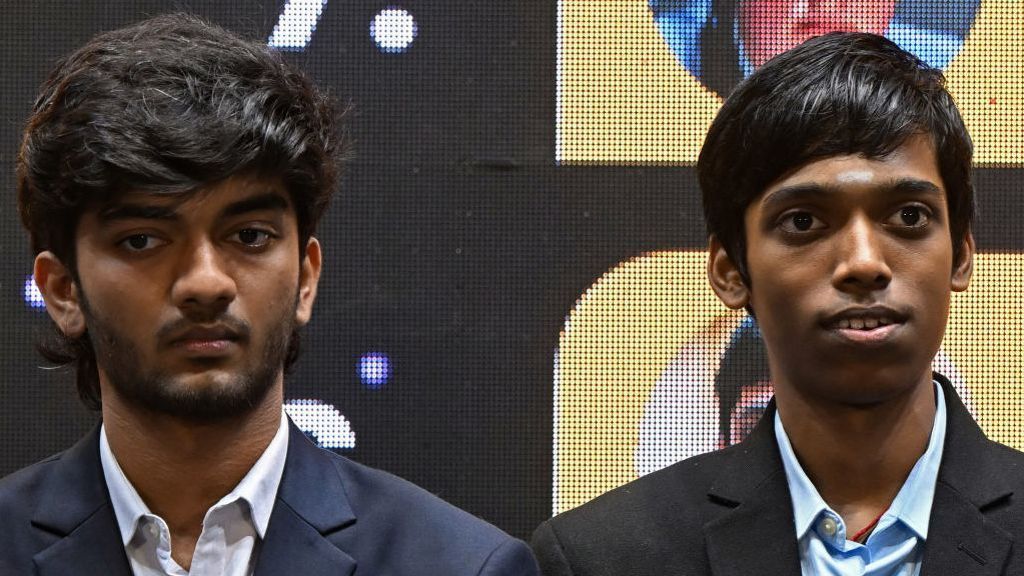India are on the cusp of a historic gold medal, maybe even two, ahead of final round of the 45th Chess Olympiad in Budapest.
The dominant Indian men’s team returned to winning ways with an emphatic win over a star-studded USA while the women’s team beat China in the 10th and penultimate round of the tournament, to make the finale a virtual gold medal shoot-off.
With one round to go, the men’s team are in sole lead with 19 out of 20 points, with Slovenia next. The women’s team, level on 17 points with Kazakhstan at the top of the table, face a must-win match against Azerbaijan. Mathematically, Indian men are well placed to win gold with a win, but a loss could bring in the Tiebreaks which is where things can get complicated.
If India win, it will be their first gold medal at the Olympiad, when held in person; the last time was they shared gold during an online Olympiad held during the pandemic. Their best performances before this have been the bronzes they won in 2022 (at Chennai) and 2014 (Tromso, Norway.)
This consistent run at a team event, which has all but confirmed gold medal in the open section (men’s), underlines the huge leap Indian chess has taken the last couple of years.
From the Candidates earlier this year, when there were four Indian men among eight challengers for the World Championship match to now being in sole gold medal position for a good part of the Olympiad against the best players in the world, the journey of these players, two of them still teenagers, is remarkable.
What do India need to win gold?
The men’s team has all but won the gold medal with their dominant run and a final-round win over Slovenia can seal it as they would then have 21/22 points.
However, the calculators can come out if India lose and China beat USA – which would mean a tie.
For the woman, the equation is more straightforward – win against Azerbaijan and hope Kazakhstan lose to USA.
China is now trailing India by two points. If India loses in the final round and China wins, the two teams will share first place. The tiebreaks will then decide the outcome, and although India has a much better tiebreak at the moment, there is still a slim chance China can… https://t.co/6RrVtWGyWH
– International Chess Federation (@FIDE_chess) September 21, 2024
According to ChessBase India, the tiebreaks are under the Olympiad Sonneborn Berger system. “While India has a higher OSB (tiebreak), It is extremely difficult to gauge if China can make up the deficit or not if match points are tied. Because OSB is essentially your score against a team multiplied by their match points. So, if all of India’s opponents don’t do well and all of China’s opponents do well, then China still has a technical chance,” it explained on X.
In other words, it will come down to the individual performances of the players even if the team loses. This is an encouraging sign for India. Arjun has been in stellar form and Gukesh has picked up great momentum in the last few rounds; both are in fact in the top 5 and close to 2800 ELO ratings. Vidit has been steady and while Praggnanandhaa has had some challenging matches, he’s managed to prevail with good draws. The wins over China (sans Ding Liren) and USA should help even as the nerves of the final round and gold medal swirl around.
The final round will start early, and come 2.30 PM IST, India are in with a genuine shot at gold.
What happened in Round 10?
Men’s section
India vs USA was a crucial match with the big names clashing and it was a cracker of a contest as expected. India won 2.5-1.5 for their ninth win, with World Championship challenger D Gukesh getting the decisive win over Fabiano Caruana.
Gukesh had another battle on his hands but held his nerve against the top seeded team and a higher ranked Caruana. It was a Catalan opening wherein Gukesh got the complications running in his favour in the later stages of the middle game after grabbing a pawn. Under pressure, Caruana crumbled and soon after lost a second pawn to let Gukesh enter a winning endgame. Gukesh’s win helped as R Praggananandhaa had gone down fighting against Wesley So to give the American team an early lead. But that proved to be the only win USA had in the end.
Arjun Erigaisi, the standout performer for India in terms of wins, had a marathon on his hands against Lenier Dominguez Perez but he was always in command, winning after over five hours of play. Vidit Gujrathi played a rock-solid game to secure a draw against Levon Aronian.
🇮🇳 India defeats 🇺🇸 USA in Round 10 of the #ChessOlympiad with a 2.5-1.5 score!
The match began with a victory for Wesley So over Praggnanandhaa R, giving the USA an early 1-0 lead. But India quickly bounced back as World Championship Challenger Gukesh D took down World #3… pic.twitter.com/aG0tXxfXTL
– International Chess Federation (@FIDE_chess) September 21, 2024
Arjun’s performance eased some of the pressure off Gukesh faced against Caruana. “It was crazy. He surprised me in the opening with his move order, and we reached an initially equal position. His problems started from Ne7. Arjun was completely winning, so I thought even a draw would be fine, but I kept finding all the good moves,” he told the FIDE broadcast.
Women’s section
Divya Deshmukh was yet again India’s standout performer as she defeated Ni Shiqun on board three, which was the only victory of the match and helped clinch the tie for India 2.5-1.5. R Vaishali was the other Indian who deserved a lot of praise for her spirited defense in a difficult position against Guo Qi and in the end capitalized on a tactical shot to force the draw.
On the top board, D Harika held on to her own to hold Zhu Jiner, while Vantika Agarwal matched Lu Miaoyi move for move to get an easy draw just when the middle game arrived. The win against China was much needed as women’s team was also in lead till eight rounds in Budapest before a loss to Poland and then a draw against the USA placed them second.
(With inputs from PTI)













